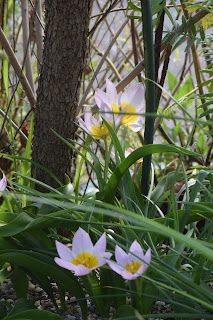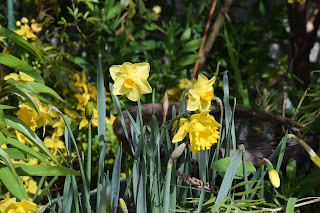Somehow we got through the winter - barely for many - but now the Equinox has arrived, plus daylight savings time. So, I'm calling it - it's spring!
Here are a few visual celebrations of early spring.
Sedum variety. This sweet little Sedum is in bloom and kind of tumbling out of its pot.
Banksia rose. It's climbed up into my Laburnum tree and is in full glorious bloom.
Daffodil Double Delight. One of my favorite Daffodil mixes.
Tulip Triumph mix. This short-stemmed hybrid tulip has begun blooming.
Tulip chrysantha Tubergen's Gem. A lovely species tulip, one that returns each year.
Scilla Excelsior. To my delight, these Scilla flowers have returned and are looking good.
My Cotinus 'Royal Purple' is already leafing out and forming tiny clusters of 'smoke' flowers.
I don't buy a lot of hybrid tulips as it's too warm here in Oakland for them to return and rebloom. But I usually buy two or three varieties, like this Apricot Impression, to enjoy in spring.
Baby Blue Eyes. here aren't many flowers bluer than this California native. And as a bonus, this year it's assumed a spilling habit.
Daffodils. This is part of a doubles mix.
Callistemon viminalis. This bottlebrush has just opened a bunch of nectar-rich flowers.
Dutch iris. One of many varieties in my garden.
Gnidia polystacha. This one of a kind California native is in full glorious bloom.
Here's one of my front yard beds. Right now it's dominated by big sheaths of Babianas.
Lonicera tatarica. No fragrance on this honeysuckle's flowers but still pretty.
Anisodontea Strybing Beauty. A real hit with bees!!
Grevillea Molongo. Always in bloom and too charming for words.
Marmalade bush. I get more 'Wow, what is that plant?' comments from passersby than anything else in my one-of-everything garden.
Aloe striata. An easy and beaut Aloe. Hummers love the orange tubular flowers.
Scabiosa Harlequin. This low growing, mat-forming Scabiosa is a blooming machine and much beloved by bees and butterflies.
Tritonia variety. One of the most prolific of all tritonias. Seeds everywhere!
Lathyrus Noel Sutton. A new sweet pea and one of the most fragrant I've ever smelled.
Leucospermum Veldfire. One of the showiest of all Leucos.
Corydalis ochroleuca. This hard to find species offers up charming alabaster flowers.


















































